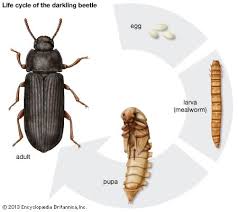Litter beetles are those dark beetles you find in poultry houses, most especially in deep litter houses. They normally hide under everything – drinkers, feeders, stones, laying boxes that are on the floor, along the walls etc. In my early days of raising chickens, I totally ignore these beetles because I thought they were harmless. But are they harmless? They are VERY harmful!
Litter beetles eat chicken feed, their larvae bore into insulations, woods etc, they climb into poultry feathers and bite them, sometimes killing weakened chickens and worst of all, they can carry a lot of poultry diseases!
The scientific name for these little destroyers is Alphitobius diaperinus. Locally, they can also be called darkling beetles, lesser mealworm, black beetles etc. They cause more problems in houses where the litter is allowed to build up without any effective control program in place.
To properly control litter beetles, it is good to know how their life cycle work. This will help you, among other things, to know where and how to apply insecticides.
Litter Beetle Life Cycle
Females lay 200-400 eggs at once every 1-5 days. Eggs hatch in 4-7 days depending on temperature. Larvae emerge and pass through several stages known as larval instars. This will last 35-65 days. During the end of this stage, the larvae will look for a dark, out of the way area to pupate. They usually bore into wood, insulations or stay along the side walls. The pupa stage last 4-7 days after which litter beetle emerge. They become sexually mature 6-7 days later, mate and the cycle continues. The whole cycle can take 40-80 days. Mature beetles can live for up to one year (can you imagine how many generations they will produce?)
The condition in poultry houses makes it ideal for beetles to survive and multiply – abundant feed and water, moisture, protection from predators, and temperature. They are usually active at night and are attracted by the smell of ammonia from poultry manure.
Damages
Effect on Feed: If uncontrolled, population can explode to levels high enough to affect how much you spend on feed.
Effect on Birds: Litter beetles cause nuisance to birds and this will reduce feed efficiency (the amount of feed needed to gain 1kg body weight will increase). Birds will eat some beetles and this will decrease feed efficiency and can also lead to impaction of the gut and enteric diseases.
Litter beetles can also transmit many diseases to birds, including IBDV, Marek’s disease, LT, Newcastle disease, RSS, E. coli, Salmonella, Dermatitis, Necrotic enterisis, coccidiosis, aspergillosis etc. Any disease the beetles come in contact with can be transmitted.
Effect on Structures: I could remember the many tiny holes I see in my laying boxes. At a point the boxes became so weak that they start falling apart. I did not knew what caused it but I know better now. Beetles can destroy woods, insulations and other soft materials, increasing your maintenance cost. For those in temperate countries that use insulated buildings, damaged insulation also means higher heating cost.
How to Control Litter Beetles
Good control requires proper litter management, good biosecurity and the correct use of insecticides. Clean up spilled feed and remove dead birds regularly. If population level explode, consider cleaning out the litter and applying insecticide to the litter.
Insecticides:
There are many insecticides you can use – cypermethrin, deltamethrin, triflumeron, lambdacyhalothrin, pyriproxyfen, thiamethoxam, imidacloprid, chlorpyrifos etc. The important thing to note is that if you use one insecticide repeatedly, a time will come when beetles will get use to the insecticide and survive it. This is called resistance development. Prevent this by rotating between insecticides with different mode of action http://www.farmersjoint.com/blog/crop-and-plantation/insecticide-resistance-how-to-use-insecticides-correctly. A good practice is to change insecticides every 2 batch of broilers or every 12 weeks.
Where to Apply: Target only those areas where beetles congregate, not the entire pen. Apply in a band that is 3ft wide under feed lines, along side walls etc. Applying to bare ground is not effective. Apply on litter where the beetles crawl over.
Don’t use too much water when applying insecticides. Use 12ml water per m2. Use only nozzles that emit fine mist to ensure proper coverage. Use the label recommended rate of insecticide, lower rates will cause resistance to develop
After 4-5 weeks of applying insecticide, check the places beetles normally congregate (under feeders and waterers, along sidewalls and under every hidden places). If few beetles are seen, the insecticide is effective. If not change to an insecticide with a different mode of action. Some insecticides are fast-acting while some act slowly over a long period of time.
Organophosphate (chlorpyrifos, dichlorvos (DDVP), malathion, profenofos, diazinon, acephate, propetamphos) and pyrethroid (bifenthrin, permethrin, cyfluthrin, beta-cyfluthrin, deltamethrin, cypermethrin, and lambda-cyhalothrin) classes of insecticides can be made more effective by adding acids (e.g. citric acid). Alkaline solution (e.g. ammonia) will increase the effectiveness of Spinosyns (e.g. spinosad). However, never mix disinfectants with insecticides. It will no longer be effective.
After cleaning out litters, apply insecticide on them in the storage shed to prevent beetles from migrating back into the pen or people’s houses.
Conclusion
I have seen many poultry farmers ignoring these little destroyers, probably because of ignorance. Litter beetles are silent and indirect killers (Rats too). Beware and share this message with other far


We are thankful be blessed by good